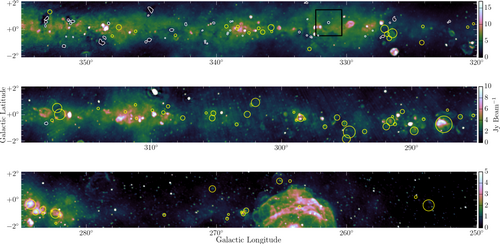The plane of the Milky Way is dominated by diffuse radio emission with a brightness temperature of thousands of Kelvin at the radio frequencies from tens to hundreds of MHz. This emission originates from relativistic electrons interacting with the Galactic magnetic field. Our Milky Way also hosts thousands of HII regions. They are formed by the young and massive stars ionizing their surrounding neutral hydrogen clouds. The HII region contains a large amount of free electrons, which absorb the synchrotron emission behind it along the line of sight. The absorption makes the HII region looks dark compared with its bright surrounding (See the picture below).
In a newly published paper, the authors mapped the 2D distribution of the Milky Way disk in the Galactic longitude range from 250 to 355 degrees. Further, they measured the synchrotron emissivity behind 47 HII regions. Due to the limited resolution of the radio telescopes, the HII region absorption observation has been suspended for ten years since 2006. The data used for this work are from the GaLactic and Extragalactic All-sky Murchison Widefield Array (GLEAM) survey. The Murchison Widefield Array (MWA) is a precursor for the Square Kilometer Array (SKA).
Four simple models are developed to reconstruct the big picture of the synchrotron distribution. Applying these models to the measurements, the authors found the synchrotron emissivity is much higher in the region near the Galactic center than that near the Galactic edge. This conclusion is opposite to Nord's based on the observation of the Very Large Array (VLA). In future, the authors of this work will get several hundreds of new measurements on a larger portion of the Milky Way disk. This will show more structures of our Milky Way. This will help to confine the spatial distribution of the Galactic magnetic field and the cosmic ray electrons.
This work is done by Hongquan Su and his collaborators from the National Astronomical Observatories of Chinese Academy of Sciences, ICRAR-Curtin and several other Universities. This work has been published online by the Monthly Notices of the Royal Astronomical Society(MNRAS,http://mnras.oxfordjournals.org/content/early/2016/11/17/mnras.stw2959.abstract).

A portion of the Galactic plane at 88 MHz with a bandwidth of 30.72 MHz observed by the MWA. The white polygon regions show the absorption regions measured in this work. The yellow circles show the HII regions without absorption features.













